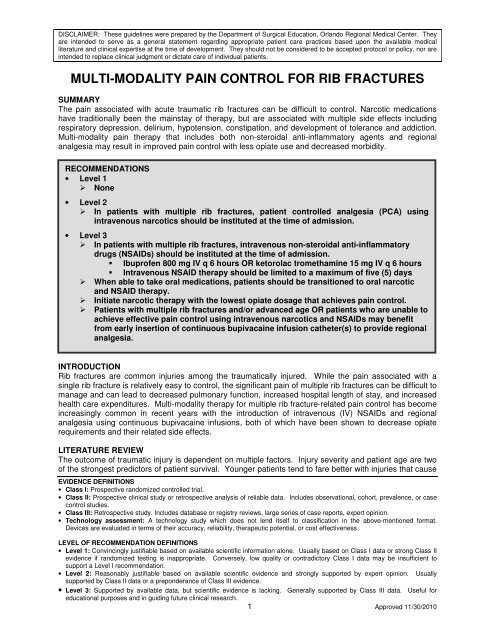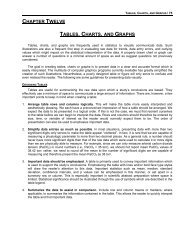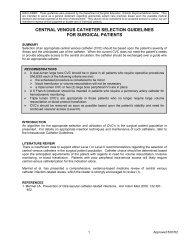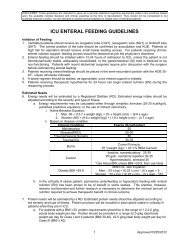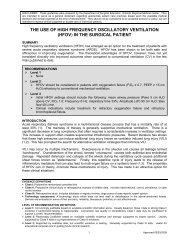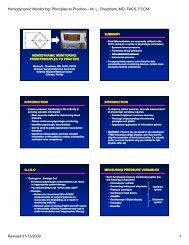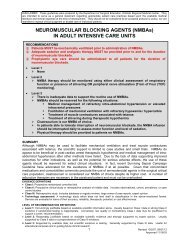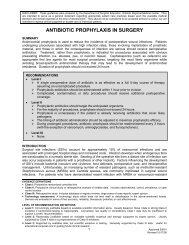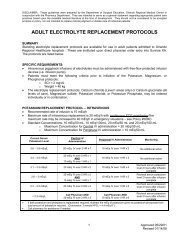multi-modality pain control for rib fractures - SurgicalCriticalCare.net
multi-modality pain control for rib fractures - SurgicalCriticalCare.net
multi-modality pain control for rib fractures - SurgicalCriticalCare.net
Create successful ePaper yourself
Turn your PDF publications into a flip-book with our unique Google optimized e-Paper software.
DISCLAIMER: These guidelines were prepared by the Department of Surgical Education, Orlando Regional Medical Center. Theyare intended to serve as a general statement regarding appropriate patient care practices based upon the available medicalliterature and clinical expertise at the time of development. They should not be considered to be accepted protocol or policy, nor areintended to replace clinical judgment or dictate care of individual patients.MULTI-MODALITY PAIN CONTROL FOR RIB FRACTURESSUMMARYThe <strong>pain</strong> associated with acute traumatic <strong>rib</strong> <strong>fractures</strong> can be difficult to <strong>control</strong>. Narcotic medicationshave traditionally been the mainstay of therapy, but are associated with <strong>multi</strong>ple side effects includingrespiratory depression, delirium, hypotension, constipation, and development of tolerance and addiction.Multi-<strong>modality</strong> <strong>pain</strong> therapy that includes both non-steroidal anti-inflammatory agents and regionalanalgesia may result in improved <strong>pain</strong> <strong>control</strong> with less opiate use and decreased morbidity.RECOMMENDATIONS• Level 1 None• Level 2 In patients with <strong>multi</strong>ple <strong>rib</strong> <strong>fractures</strong>, patient <strong>control</strong>led analgesia (PCA) usingintravenous narcotics should be instituted at the time of admission.• Level 3 In patients with <strong>multi</strong>ple <strong>rib</strong> <strong>fractures</strong>, intravenous non-steroidal anti-inflammatorydrugs (NSAIDs) should be instituted at the time of admission. Ibuprofen 800 mg IV q 6 hours OR ketorolac tromethamine 15 mg IV q 6 hours Intravenous NSAID therapy should be limited to a maximum of five (5) days When able to take oral medications, patients should be transitioned to oral narcoticand NSAID therapy. Initiate narcotic therapy with the lowest opiate dosage that achieves <strong>pain</strong> <strong>control</strong>. Patients with <strong>multi</strong>ple <strong>rib</strong> <strong>fractures</strong> and/or advanced age OR patients who are unable toachieve effective <strong>pain</strong> <strong>control</strong> using intravenous narcotics and NSAIDs may benefitfrom early insertion of continuous bupivacaine infusion catheter(s) to provide regionalanalgesia.INTRODUCTIONRib <strong>fractures</strong> are common injuries among the traumatically injured. While the <strong>pain</strong> associated with asingle <strong>rib</strong> fracture is relatively easy to <strong>control</strong>, the significant <strong>pain</strong> of <strong>multi</strong>ple <strong>rib</strong> <strong>fractures</strong> can be difficult tomanage and can lead to decreased pulmonary function, increased hospital length of stay, and increasedhealth care expenditures. Multi-<strong>modality</strong> therapy <strong>for</strong> <strong>multi</strong>ple <strong>rib</strong> fracture-related <strong>pain</strong> <strong>control</strong> has becomeincreasingly common in recent years with the introduction of intravenous (IV) NSAIDs and regionalanalgesia using continuous bupivacaine infusions, both of which have been shown to decrease opiaterequirements and their related side effects.LITERATURE REVIEWThe outcome of traumatic injury is dependent on <strong>multi</strong>ple factors. Injury severity and patient age are twoof the strongest predictors of patient survival. Younger patients tend to fare better with injuries that causeEVIDENCE DEFINITIONS• Class I: Prospective randomized <strong>control</strong>led trial.• Class II: Prospective clinical study or retrospective analysis of reliable data. Includes observational, cohort, prevalence, or case<strong>control</strong> studies.• Class III: Retrospective study. Includes database or registry reviews, large series of case reports, expert opinion.• Technology assessment: A technology study which does not lend itself to classification in the above-mentioned <strong>for</strong>mat.Devices are evaluated in terms of their accuracy, reliability, therapeutic potential, or cost effectiveness.LEVEL OF RECOMMENDATION DEFINITIONS• Level 1: Convincingly justifiable based on available scientific in<strong>for</strong>mation alone. Usually based on Class I data or strong Class IIevidence if randomized testing is inappropriate. Conversely, low quality or contradictory Class I data may be insufficient tosupport a Level I recommendation.• Level 2: Reasonably justifiable based on available scientific evidence and strongly supported by expert opinion. Usuallysupported by Class II data or a preponderance of Class III evidence.• Level 3: Supported by available data, but scientific evidence is lacking. Generally supported by Class III data. Useful <strong>for</strong>educational purposes and in guiding future clinical research.1 Approved 11/30/2010
significant morbidity and mortality among older patients. Multiple <strong>rib</strong> <strong>fractures</strong> are associated with asignificantly increased morbidity and mortality compared to single <strong>rib</strong> <strong>fractures</strong>. Bulger et al. showed adifference in mortality of 10% vs. 22% in young (18-64 years) vs. old (≥ 65 years) patients with <strong>rib</strong><strong>fractures</strong> (1). There were also differences in ventilator days (3.1 vs. 4.3 days), intensive care unit days(4.0 vs. 6.1 days), and hospital length of stay (10.7 vs. 15.4 days) among young vs. old patients.Recent data has shown that patient <strong>control</strong>led analgesia (PCA) imparts a significant survival advantage inelderly patients with blunt chest trauma (2). This study also demonstrated a protective trend towardimproved survival in elderly <strong>rib</strong> fracture patients with the use of an NSAID agent such as ketorolactromethamine.IV ibuprofen has recently become available as a non-narcotic adjunct <strong>for</strong> the treatment of post-surgicaland post-trauma <strong>pain</strong>. Southworth et al. studied the use of IV ibuprofen in a <strong>multi</strong>center randomized trialof elective orthopedic and abdominal surgery patients (3). Patients were given IV morphine by PCA andrandomized to receive either 400 or 800 mg of IV ibuprofen, or placebo. The first dose of study drug wasadministered intra-operatively at closure of the surgical wound. It was then given every six (6) hours <strong>for</strong>the first 48 hours of admission. The drug was then continued at the discretion of the investigator <strong>for</strong> up toa maximum of five (5) days. Median morphine use was significantly less in the 800 mg ibuprofen group(22% vs. placebo; p=0.03). Median <strong>pain</strong> scores were also significantly less in the 800 mg and 400 mgibuprofen groups compared to placebo.Another recent trial involving elective orthopedic procedures randomized patients to 800 mg IV ibuprofenvs. placebo starting preoperatively and given every six (6) hours (4). The treatment arm had a 26%reduction in visual analog scale (VAS) <strong>pain</strong> perception scores in the immediate post-operative period.Both treatment groups had access to morphine <strong>for</strong> breakthrough <strong>pain</strong>. There was a 31% decrease inmorphine usage in the 800 mg ibuprofen group. Drug related adverse events were similar with ibuprofenand placebo.Contraindications to ibuprofen usage include, but are not limited to (5): Known hypersensitivity to ibuprofen or other NSAIDs Asthma, urticaria, or allergic-type reactions after taking aspirin or NSAIDs Peri-operative use in the setting of coronary artery bypass graft (CABG)Precautions <strong>for</strong> ibuprofen usage Serious and potentially fatal cardiovascular thrombotic events Serious gastrointestinal reactions Hepatic effects Hypertension Congestive heart failure and edema Renal impairment Serious skin reactions (Stevens-Johnson Syndrome, Toxic Epidermal Necrolysis)Regional analgesia <strong>for</strong> <strong>rib</strong> <strong>fractures</strong> has been studied using thoracic epidural analgesia (TEA) andthoracic paravertebral infusion (TPI). Mohta et al. randomized 30 patients to either TEA or TPI withcontinuous bupivacaine infusion (6). VAS <strong>pain</strong> scores, respiratory rate, peak expiratory flow rate, andPaO 2 /FiO 2 ratios were measured be<strong>for</strong>e and after block administration at regular intervals. Narcoticusage <strong>for</strong> breakthrough <strong>pain</strong> <strong>control</strong> was tracked. Complications of each method were recorded. Bothinterventions were found to improve <strong>pain</strong> scores and have similar complication rates. TEA and TPI,however, can be technically demanding and may require significant patient cooperation which may not befeasible in the intensive care unit.Continuous bupivacaine infusion catheter therapy (On-Q <strong>pain</strong> relief system, I-Flow Corp, Lake Forest,CA) has been compared with thoracic epidural analgesia. Wheatley et al. compared the On-Q devicevs. epidural analgesia in patients who underwent thoracotomy (7). Continuous bupivacaine infusionachieved better <strong>pain</strong> <strong>control</strong> as evidenced by decreased <strong>pain</strong> scores and narcotic use with the On-Qdevice at the incisional area.2 Approved 11/30/2010
No study to-date has compared the On-Q pump vs. epidural analgesia <strong>for</strong> <strong>rib</strong> <strong>fractures</strong>. The relativeease of placement of this device should provide effective regional analgesia without the risks associatedwith epidural catheters.The total dosage of bupivacaine infused should be closely monitored to avoid overdose. Significantcardiac depression leading to atrioventricular block, ventricular arrhythmias, and death can result fromoverdose. Central nervous system depression, stimulation, or both can occur as well. Apparent centralstimulation is manifested as restlessness, tremors and shivering progressing to convulsions, followed bydepression and coma progressing ultimately to respiratory arrest (8). Further details can be found in theevidence based medicine guideline, “Paracostal Infusion of Bupivacaine <strong>for</strong> Management of RibFracture Pain”, available at www.surgicalcriticalcare.<strong>net</strong>.REFERENCES1. Bulger EM, Arneson MA, Mock CN, Jurkovich GJ. Rib <strong>fractures</strong> in the elderly. J Trauma 2000; 48(6):1040-1047.2. Harrington DT, Phillips B, Machan J, Zacharias N, Velmahos GC, Rosenblatt MS, Winston E,Patterson L, Desjardins S, Winchell R, Brotman S, Churyla A, Schulz JT, Maung AA, Davis KA.Factors associated with survival following blunt chest trauma in older patients: results from a largeregional trauma cooperative. Arch Surg 2010; 145(5):432-437.3. Southworth S, Peters J, Rock A, Pavliv L. A <strong>multi</strong>center, randomized, double-blind, placebo-<strong>control</strong>ledtrial of intravenous ibuprofen 400 and 800 mg every 6 hours in the management of postoperative<strong>pain</strong>. Clin Ther 2009; 31(9):1922-1935.4. Singla N, Rock A, Pavliv L. A <strong>multi</strong>-center, randomized, double-blind placebo-<strong>control</strong>led trial ofintravenous-ibuprofen (IV-ibuprofen) <strong>for</strong> treatment of <strong>pain</strong> in post-operative orthopedic adult patients.Pain Med 2010; 11(8):1284-1293. Epub 2010 Jun 305. Caldolor (ibuprofen) injection presc<strong>rib</strong>ing in<strong>for</strong>mation. Cumberland Pharmaceuticals Inc., Nashville,TN, 20096. Mohta M, Verma P, Saxena AK, Sethi AK, Tyagi A, Girotra G. Prospective, randomized comparisonof continuous thoracic epidural and thoracic paravertebral infusion in patients with unilateral <strong>multi</strong>plefractured <strong>rib</strong>s--a pilot study. J Trauma 2009; 66(4):1096-1101.7. Wheatley GH 3rd, Rosenbaum DH, Paul MC, Dine AP, Wait MA, Meyer DM, Jessen ME, Ring WS,DiMaio JM.Improved <strong>pain</strong> management outcomes with continuous infusion of a local anesthetic afterthoracotomy. J Thorac Cardiovasc Surg 2005; 130(2):464-468.8. Micromedex September 20103 Approved 11/30/2010
Multiple Rib Fracture Pain Management AlgorithmPatient with <strong>multi</strong>ple<strong>rib</strong> <strong>fractures</strong>Begin intravenousnarcotic PCAContraindicationto NSAID therapy?ABBREVIATIONSNSAID – non-steroidal anti-inflammatory drugPCA – patient <strong>control</strong>led anesthesiaNSAID CONTRAINDICATIONSKnown hypersensitivity to NSAIDsAsthma, urticaria, or allergic-type reactionsafter taking aspirin or NSAIDsPeri-operative use in the setting of coronaryartery bypass graftingRenal impairmentNOYESBegin intravenousNSAID therapySevere chestwall injury?YESInsert paracostalinfusion catheterTransition to oraltherapy as toleratedNONOAdequate <strong>pain</strong><strong>control</strong>?YES4 Approved 11/30/2010


